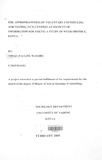| dc.description.abstract | HIV/AIDS is an impairment of the body's ability to fight disease. The disease is mainly
spread through sexual intercourse. The youth are exposed to HIV/AIDS due to
biological, socio-cultural and economic factors. Youth vulnerability to HIV /AIDS is
made worse by the fact that parents, leaders and teachers have difficulties discussing
matters related to sexuality with young people. This has created a vacuum of
knowledge, making it difficult for the youth to handle HIV/AIDS effectively.
VCT is an essential component of an effective response to the AIDS epidemic. The aim
of this study was to find out whether there existed a sufficiently strong empirical basis
for introducing VCT services to secondary school students. The study therefore sought
to find out whether the youth in secondary schools had access to accurate and reliable
sources ofHIV/AIDS information and counselling on a regular basis.
The study was carried out in Nyeri district, Central province, Kenya. The study was a
survey using ex-post facto research design. Stratified random sampling and simple
random sampling were used in both the selection of schools and in the selection of
students. A total sample size of 118 students were selected and interviewed from the
eight schools that were sampled. One teacher-counsellor from each of the eight selected
schools and four VCT counsellors were also interviewed.
Different data collection instruments were used in the study. Two different interview
schedules were developed to collect data from the students and the teacher-counsellors.
An interview guide was used to collect data from the VCT counsellors. After data
collection, SPSS was used to analyze the data. Descriptive and inferential statistics
were used to present and interpret the data.
The study found that very limited HIV/AIDS counselling was being done in secondary
schools. The majority of the students reported having insufficient information on
HIV/AIDS. However, the same study observed that very few students approached their
teacher-counsellors for HIV/AIDS counselling. Although the majority of the students
and the teacher-counsellors reported that the students had fairly good access to
HIV/AIDS information that was available in the schools, the teacher-counsellors
revealed that the HIV/AIDS audio and visual resources were very limited. In addition,
all the teacher-counsellors who were interviewed had no training in HIV/AIDS
counselling, and very few had any training in counselling.
The study found that although the majority of the youth were abstaining from sexual
intercourse, a small percentage of them were still engaging and some of them had not
taken any HIV/AIDS protective measures. This implies that the youth are still
vulnerable to HIV/AIDS and therefore, more HIV/AIDS information and counselling is
still needed to make them better equipped to face the HIV/AIDS pandemic.
Most of the students, the teacher-counsellors and half of the VCT counsellors
recommended that VCT services be offered to students. In addition, more than three
quarters of the students reported that they would like to fmd out their HIV status.
However, very few students reported having ever visited a VCT site and very few
clients at the VCT sites were reported to have been below 18 years. This implied that
the VCT centers either have not made their services widely known to the youth or there
is something about them that is not very appealing to the youth.
Results of the hypotheses tests showed that other factors other than teacher-counsellors
teaching load, limited counselling skills, lack of well organized guidance and
counselling programmes in schools and limited utilization of VCT sites by the youth
contributed to students limited access to HIV/AIDS information and counselling. As a
result the researcher recommends that further studies be done to establish how
HIV/AIDS information and counselling can be made more accessible to the youth. In
the meantime, basic counselling training including HIV/AIDS counselling training
should be offered to all the teacher-counsellors to enable them to do their counselling
job more effectively. | en |

